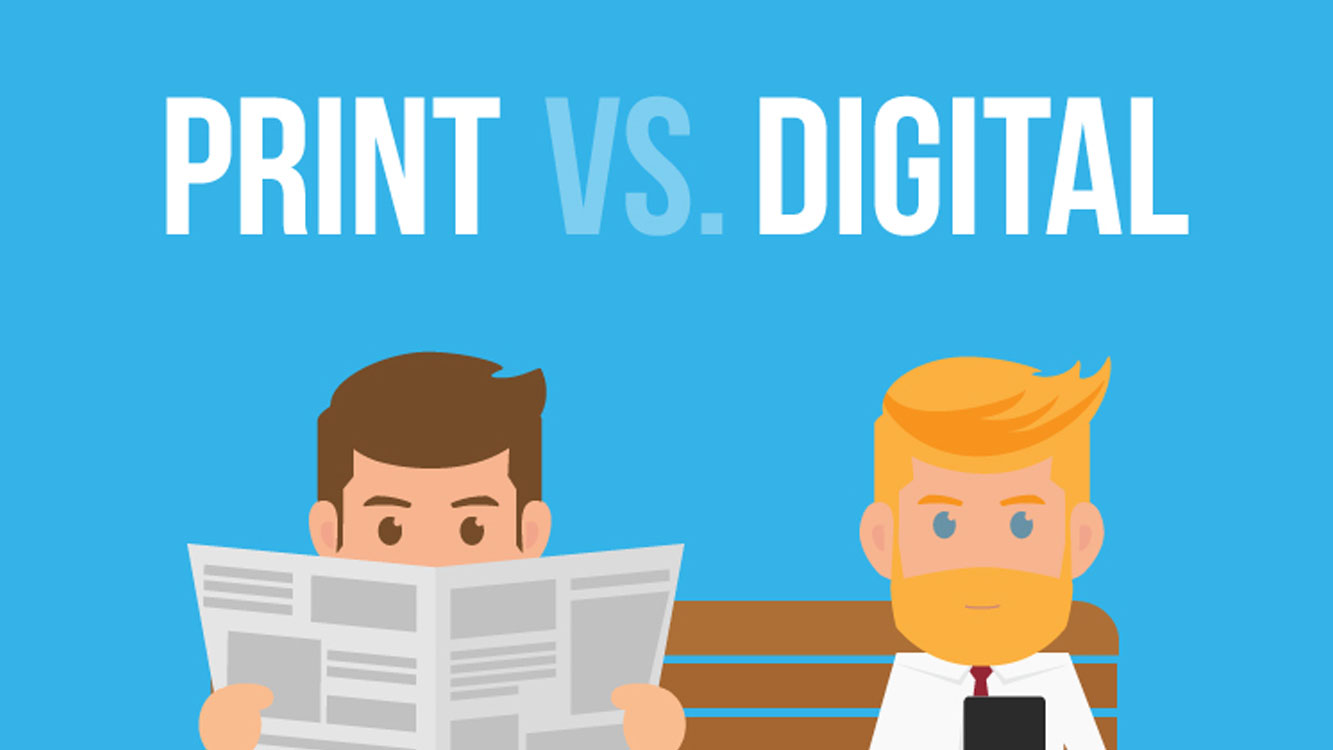
Data-Driven Creativity: AI’s Impact on Ad Concepts and Design
June 25, 2024
Top Trends in Video Ad Production for 2024
June 25, 2024
In the dynamic world of advertising, businesses are constantly searching for the most effective ways to reach and engage their audiences. The debate between print and digital advertising has persisted for years, with each medium offering unique benefits and challenges. As we enter 2024, the question remains: which is more effective, print or digital ads?
Print advertising has a long history of success, known for its tangible presence and ability to create lasting impressions. Magazines, newspapers, and flyers have been staple tools for marketers aiming to capture the attention of local and older demographics. On the other hand, digital advertising has revolutionized the industry with its vast reach, precise targeting, and real-time analytics. Online ads, social media promotions, and email marketing have become essential for businesses targeting tech-savvy and global audiences.
This article will explore the effectiveness of print versus digital ads in 2024. We’ll examine the strengths and limitations of each medium, considering factors such as reach, engagement, cost, and consumer trust. By understanding the nuances of both print and digital advertising, businesses can make informed decisions and craft more comprehensive marketing strategies that resonate with their target audiences.
1. Reach and Accessibility
Digital Ads:
- Wider Reach: Digital ads can reach a global audience instantly, breaking geographical barriers. With billions of people using the internet daily, digital platforms offer unparalleled reach.
- Targeting Capabilities: Advanced targeting options allow advertisers to reach specific demographics, interests, and behaviors, ensuring that ads are shown to the most relevant audiences.
Print Ads:
- Localized Reach: Print ads are particularly effective for local businesses targeting specific communities. Local newspapers, magazines, and flyers can efficiently reach a geographically concentrated audience.
- Tangible Presence: Physical ads have a tangible presence that can make a lasting impression, especially for audiences less engaged with digital media.
2. Engagement and Attention
Digital Ads:
- Interactive Content: Digital ads can be interactive, engaging users through videos, animations, and clickable content. This interactivity can enhance user engagement and lead to higher conversion rates.
- Short Attention Spans: Online users often have shorter attention spans, and digital ads must capture interest quickly to be effective. Ad blockers and banner blindness can also reduce visibility.
Print Ads:
- Focused Attention: Readers of print media tend to be more focused and engaged, often spending more time with content. This can lead to a deeper connection with the advertisement.
- Less Clutter: Print media typically has less ad clutter compared to digital platforms, reducing competition for attention and making each ad more prominent.
3. Cost and Flexibility
Digital Ads:
- Cost-Effective: Digital advertising can be more cost-effective, with options to set budgets and pay per click or impression. This flexibility allows businesses of all sizes to advertise online.
- Real-Time Adjustments: Advertisers can track performance metrics in real-time and adjust campaigns instantly. This agility helps optimize ad spend and improve effectiveness.
Print Ads:
- Higher Production Costs: Print ads often involve higher production and distribution costs. Designing, printing, and distributing physical materials can be more expensive than creating digital content.
- Limited Flexibility: Once a print ad is published, it cannot be changed. This lack of flexibility means mistakes or changes in strategy can be costly.
4. Measuring Effectiveness
Digital Ads:
- Detailed Analytics: Digital platforms provide detailed analytics, allowing advertisers to measure impressions, clicks, conversions, and more. This data-driven approach helps refine strategies and demonstrate ROI.
- Attribution Challenges: Despite the abundance of data, attributing conversions solely to digital ads can be complex due to the multi-touch nature of digital marketing.
Print Ads:
- Impactful Branding: Print ads can have a significant impact on brand perception and credibility, which may not be immediately measurable but contributes to long-term brand equity.
- Measurement Difficulties: Measuring the direct impact of print ads can be challenging. Tools like QR codes and custom URLs can help track engagement, but overall, it is harder to quantify effectiveness compared to digital.

5. Consumer Trust and Credibility
Digital Ads:
- Trust Issues: Some consumers are wary of digital ads due to privacy concerns and the prevalence of online scams. However, trusted platforms and brands can overcome this barrier.
- Dynamic Content: The ability to provide up-to-date and relevant content in real-time helps build trust and maintain audience interest.
Print Ads:
- High Credibility: Print media, especially well-established newspapers and magazines, often carries a high level of credibility. Readers tend to trust print ads more, viewing them as more legitimate and less intrusive than digital ads.
- Enduring Impact: Print ads can be kept, shared, and revisited, offering a lasting impression that digital ads may lack.
6. Environmental Considerations
Digital Ads:
- Eco-Friendly: Digital advertising is generally more environmentally friendly, reducing the need for paper and physical materials. This aspect appeals to eco-conscious consumers and businesses.
- Energy Use: However, digital advertising requires energy-intensive data centers and electronic devices, which have their own environmental impact.
Print Ads:
- Sustainability Concerns: Print advertising involves the use of paper and ink, contributing to deforestation and waste. However, sustainable practices like using recycled paper and eco-friendly inks are becoming more common.
- Recyclability: Printed materials can be recycled, which helps mitigate some environmental impacts.
7. Brand Awareness and Recall
Digital Ads:
- Frequent Exposure: Digital ads can be displayed repeatedly to target audiences across various platforms, enhancing brand visibility. Retargeting campaigns can remind users of products they’ve viewed, increasing brand recall.
- Ad Fatigue: However, overexposure to digital ads can lead to ad fatigue, where users become desensitized to ads or actively avoid them, reducing their effectiveness over time.
Print Ads:
- Memorable Impressions: Print ads often leave a lasting impression due to their physical presence and high-quality visuals. Readers can engage with print ads at their own pace, leading to better retention and recall.
- Limited Frequency: The limited publication frequency of print media means fewer opportunities for repeated exposure compared to digital ads, which can affect long-term brand awareness.
.jpg?width=800&name=Seagull%20bolg%20images_01_02%20(1).jpg)
8. Creative Opportunities
Digital Ads:
- Dynamic Content: Digital ads offer creative opportunities through multimedia content, including videos, animations, and interactive elements. These formats can capture attention and provide engaging brand experiences.
- Customization: Digital platforms allow for extensive customization and personalization, enabling advertisers to tailor creative content to specific audiences and contexts.
Print Ads:
- High-Quality Visuals: Print ads can utilize high-quality images, textures, and designs that stand out visually. The tactile experience of a glossy magazine ad or a textured flyer can enhance the sensory appeal.
- Creative Constraints: While print ads can be visually stunning, they lack the interactivity and multimedia elements of digital ads. Creativity is often limited to static images and text.
9. Audience Demographics
Digital Ads:
- Younger Demographics: Digital advertising tends to be more effective for younger, tech-savvy audiences who spend a significant amount of time online. Social media platforms, streaming services, and websites are prime venues for reaching millennials and Gen Z.
- Diverse Audiences: With the vast reach of digital platforms, advertisers can tap into diverse and niche audiences that might be harder to reach through print media.
Print Ads:
- Older Demographics: Print ads can be more effective for reaching older audiences who may prefer traditional media such as newspapers and magazines. This demographic is often more trusting of print media.
- Local Communities: Print ads are also beneficial for targeting local communities, especially in regions where digital penetration is lower or where print media remains a primary source of information.
10. Integration with Other Marketing Channels
Digital Ads:
- Omnichannel Marketing: Digital ads can seamlessly integrate with other online marketing channels, such as social media, email marketing, and SEO, creating a cohesive and comprehensive marketing strategy.
- Cross-Platform Tracking: The integration of digital ads with other platforms allows for detailed tracking of customer journeys across multiple touchpoints, providing insights into how different channels contribute to conversions.
Print Ads:
- Supporting Digital Campaigns: Print ads can complement digital campaigns by driving offline audiences to online platforms. Including QR codes, URLs, and social media handles in print ads can bridge the gap between offline and online engagement.
- Event Marketing: Print ads are effective for promoting events, such as trade shows, conferences, and local happenings, where tangible materials like brochures, flyers, and posters can enhance the event’s visibility and appeal.
Conclusion
The debate between print and digital advertising is not about choosing one over the other but understanding how each can be leveraged to meet specific marketing goals. In 2024, both print and digital ads hold significant value, each offering distinct advantages that can enhance a comprehensive advertising strategy.
Digital advertising excels in reach, targeting, cost-effectiveness, and real-time engagement, making it indispensable for businesses aiming to connect with a wide and diverse audience quickly. Its interactive and data-driven nature allows for continuous optimization and precise measurement of campaign performance.
Print advertising, on the other hand, provides a tangible and credible presence that can deeply resonate with certain demographics and local communities. Its ability to create memorable and lasting impressions, coupled with its high trust factor, makes it a powerful tool for building brand credibility and loyalty.
Ultimately, the most effective approach in 2024 is likely a hybrid strategy that combines the strengths of both print and digital ads. By integrating these mediums, businesses can maximize their reach, engagement, and impact, creating well-rounded campaigns that cater to both online and offline audiences. This balanced approach ensures that marketing efforts are versatile, adaptive, and capable of meeting the evolving needs and preferences of consumers in an increasingly digital world.


